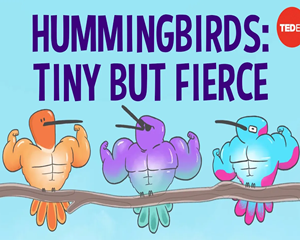And the clock starts... now. Did you miss it? It wasn't some bug buzzing by or a weird trick of the light.
即将开始...就是现在。你看到了吗?那不是什么嗡嗡飞过的虫子,也不是什么奇怪的光线把戏。
You just saw a hummingbird perform astonishing aerial acrobatics, eat lunch in midair, pollinate a flower,
你刚刚看到的是一只蜂鸟。它表演了惊人的空中特技:在半空中吃午餐,为一朵花授粉,
and then escape a threat upside down -- all in a matter of seconds.
然后倒着飞来逃离威胁,一切都发生在数秒之间。
So let's slow down the action, and unpack each step in this blazing-fast feast. First up, their incredibly rapid flight.
让我们放慢这些动作,拆解这场如闪电般快速的视觉盛宴。首先,是它们极其快速的飞行。
Hummingbirds typically beat their wings 30 to 40 times per second, creating the high-frequency hum they're named for.
蜂鸟每秒通常能拍翅30到40下,这会产生高频的嗡嗡声,它们的英文名字也是由此而来。
To flap their wings at this speed, hummingbirds have evolved giant pectoral muscles that comprise over a third of some species' bodyweight.
为了以这种高速拍打翅膀,蜂鸟进化出巨大的胸肌,有几种蜂鸟的胸肌甚至占了体重的三分之一。
But the real secret to their fine-tuned flight is all in the wrist.
但这个精心调整的飞行方式,奥秘在于它们的腕关节。
Most birds only generate lift on the downstroke of each flap, while using the upward recovery stroke to set up their next wing beat.
绝大多数的鸟,只能在每次往下挥翅的时候产生升力,而翅膀往上时,则是为下一次的挥翅做准备。
Hummingbirds however, turn their wrists during the upstroke,
但蜂鸟在举起翅膀时,会转动它们的腕关节,
changing their wing's angle to flap in a figure 8 pattern that continually generates lift throughout their wingbeats.
改变翅膀的角度,以8字型拍打翅膀,如此一来,在整个拍翅的过程中,就能持续产出升力。
Alongside their massive muscles, this special lift-producing technique allows hummingbirds to achieve sustained hovering flight -- an aerial feat no other bird can perform.
除了它们巨大的肌肉,这种特殊的腾升技术,让它们能够在空中悬浮,这是其他鸟类都无法做到的空中绝技。
Hovering lets hummingbirds slow to a stop almost instantly and assess scenarios in midair.
悬浮能让蜂鸟瞬间减速,几乎能立即停止行进,并评估空中的各种可能情况。
Then, they can take off in any direction, reaching speeds faster than a fighter jet, relative to the bird's size.
然后,它们又能往任何方向起飞,将蜂鸟的体型纳入考虑,它们的速度比喷射战斗机更快。
And since they can beat each of their wings at different speeds and angles,
而因为它们能以不同速度与角度分别拍动翅膀,
the birds can perform incredible spins and turns all while flying backwards or even upside down.
它们能在向后飞或倒着飞的时候,同时做出惊人的急转或回旋。

Of course, flying this way can be exhausting. Hovering is one of the most energy intensive forms of movement in the animal kingdom.
当然,以这种方式飞行很耗体力。悬浮是动物王国中最耗能的移动方法之一。
And relative to their body size, hummingbirds have the highest metabolic rates of all vertebrates.
而考虑到它们的体型大小,蜂鸟的新陈代谢率是脊椎动物中最高的。
This leads them to eat very frequently -- often consuming an average of four meals an hour while flying.
这让它们必须频繁进食,在飞行时,通常15分钟就得吃一餐。
Fortunately, their hovering lets them eat at remarkable angles without perching, consuming food that would otherwise be impossible to reach.
幸运的是,它们的悬浮技能能让它们不必停下,以惊人的角度,成功吃到以平常的方法构不着的食物。
Using their long slender bills, they reach deep inside flowers and pump out nectar with their thin grooved tongues.
它们能用细长的喙深入花心,再用它们细长且有沟槽的舌头,将花蜜抽进口中。
This sugary liquid is a hummingbird's most important energy source,
这种含糖液体是蜂鸟最重要的能量来源,
and a single bird consumes six times its weight in nectar every day over hundreds of small meals.
如果把一只蜂鸟每天数百顿的简餐加起来,它们摄取的花蜜总量高达自己体重的六倍。
Each of these sugary snacks also pollinates the flower being visited with pollen left on the bird from previous meals.
在蜂鸟采食每一份含糖点心的时候,它们同时也会沾上花粉,为下一朵被拜访的花授粉。
That's just a rough idea of what hummingbirds can do in several seconds.
以上只是大略说明蜂鸟在数秒内能做到什么事。
But if we hang around a little longer, we might see their aerial acrobatics put to a more dangerous test.
但如果我们再待久一点,我们也许能看见,它们的空中特技受到更危险的考验。
Hummingbirds keep track of which flowers they've recently drained, as well as those they plan to drain next.
蜂鸟总是密切关注着它们最近吸干的花,还有那些它们计划要去采蜜的花。
And each bird will fight ruthlessly to defend this floral territory from their only real competition: other hummingbirds.
每只蜂鸟都会为了保卫花花领地冷酷无情地战斗,而它们唯一真正的竞争者即是:其他蜂鸟。
Using their spear-like bills and blindingly fast flight, dueling hummingbirds chase each other through the air, aggressively stabbing and plucking feathers.
决斗的两只蜂鸟用它们尖矛般的喙,以及令人眼花撩乱的快速飞行在空中互相追逐,狠刺对方并啄去羽毛。
The bills of some species are specialized for fighting, with spiny tips, hooks, or even saw-like serrations.
有些种类特化出战斗专用的喙,它们有带刺的喙尖、倒钩,甚至还有针状的细齿。
Some hummingbirds employ these aerial fencing techniques to chase off larger birds like hawks and owls.
有些蜂鸟也将这些空中比武技术运用在驱逐鹰或猫头鹰等更大的鸟上。
But the most extreme fights are between male hummingbirds competing for flowers and females.
但最激烈的打斗莫过于两只公蜂鸟争夺花朵与母蜂鸟。
Fortunately, these duels are rarely deadly.
幸运的是,这些决斗几乎都不会致命。
After 15 to 20 seconds, one bird will typically surrender -- flying off to seek its breakfast elsewhere.
在15到20秒后,通常就会有一只蜂鸟率先投降,飞往别的地方寻找早餐。
After all this fighting, feeding, and flying, hummingbirds sometimes need to sleep off the day's events in a mild form of hibernation called torpor.
在这些打斗、觅食跟飞行后,蜂鸟有时必须以休眠这种温和的冬眠形式,恢复因白天一连串事件而消耗的体力。
Their hearts -- proportionally the largest in the animal kingdom -- slow from 1,200 beats per minute to a mere 50.
它们的心脏重量占全身体重的比例是动物王国中最高的,它们一分钟的心跳数会从1200下逐渐降到仅有50下。
But when they wake up 4 to 7 hours later, their lightning-fast metabolism kicks back into gear.
但在4到7小时后,等到它们醒来,它们如闪电般快速的新陈代谢率又会再度启动。
With all this speed and strength, it's no wonder the Aztecs revered these energetic birds as agents of the god of war Huitzilopotchli
蜂鸟拥有这种速度跟力量,也难怪阿兹特克人会认为这些精力充沛的鸟是战神维齐洛波奇特利的使者,
a reminder that immense power can come in the smallest packages.
这也提醒着我们记得:微小的事物中,也可能蕴藏着巨大的力量。


